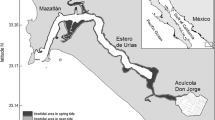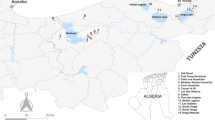Abstract
The movements of two species of predatory whelks (Muricidae: Gastropoda) were examined on several rocky seashores in New South Wales, Australia, from 1980 to 1984. The smaller species, Morula marginalba Blainville, moved less far than the larger species, Thais orbita (Gmelin). Intermittent but rapid movement allowed T. orbita to shelter in exposed places low on the shore, but to feed on their preferred prey, barnacles, much higher up to shore. This resulted in a dynamic and unpredictable pattern of vertical foraging movements for this species. Compared to areas with intact prey or with barnacles that had been killed but not removed, M. marginalba moved quickly away from areas from which barnacles had been experimentally removed. Many M. marginalba left experimental plots on two shores without prey or crevices in which to shelter, whereas some stayed over 30 d in areas with either prey or crevices (but not both), and most remained in plots where both prey and crevices were available. Thus, the presence of suitable prey and crevices seems to influence the movements of both species, which respond in different ways, corresponding to their different mobilities. These results are discussed in relation to the behavioural cues involved and predation by the whelks.
Similar content being viewed by others
Literature cited
Andrew, N. L., Stocker, L. J. (1986). Dispersion and phagokinesis in the echinoid Evechinus chloroticus (Val.). J. exp. mar. Biol. Ecol. 100: 11–23
Black, R. (1978). Tactics of whelks preying on limpets. Mar. Biol. 46: 157–162
Butler, A. J. (1979). Relationships between height on the shore and size distribution of Thais spp. (Gastropoda: Muricidae). J. exp. mar. Biol. Ecol. 41: 163–194
Connell, J. H. (1961). The effect of competition, predation by Thais lapillus and other factors on natural populations of the barnacle Balanus balanoides. Ecol. Monogr. 31: 61–104
Connell, J. H. (1970). A predator-prey system in the marine intertidal region. I. Balanus glandula and several predatory species of Thais. Ecol. Monogr. 40: 49–78
Connell, J. H. (1974). Field experiments in marine ecology. In: Marsiscal, R. (ed.) Experimental marine biology. New York, Academic Press, p. 1–54.
Denley, E. J. (1981). The ecology of the intertidal barnacle Tesseropora rosea. Unpublished Ph. D. thesis, University of Sydney
Denley, E. J., Underwood, A. J. (1979). Experiments on factors influencing settlement, survival and growth of two species of barnacles in NSW. J. exp. mar. Biol. Ecol. 36: 269–293
Fairweather, P. G. (1988a). Predation creates haloes of bare space among prey on rocky seashores in New South Wales. Aust. J. Ecol. 13: (In press)
Fairweather, P. G. (1988b). Correlations of predatory whelks with intertidal prey at several scales of time and space.Mar. Ecol. Prog. Ser. 45: 237–245
Fairweather, P. G., Underwood, A. J., Moran, M. J. (1984). Preliminary investigations of predation by the whelk Morula marginalba. Mar. Ecol. Prog. Ser. 17: 143–156
Feare, C. J. (1970). Aspects of the ecology of an exposed shore population of dogwhelks Nucella lapillus (L.).Oecologia 5: 1–18
Garrity, S.D., Levings, S. C. (1981). A predator-prey interaction between two physically and biologically constrained tropical gastropods: direct, indirect and community effects. Ecol. Monogr. 51: 267–286
Grahame J., Mill, P. J. (1986). Relative size of the foot of two species of Littorina on a rocky shore in Wales. J. Zool. Lond. (Ser. A) 208: 229–236
Jernakoff, P., Fairweather, P. G. (1985). An experimental analysis of interactions among several intertidal organisms. J. exp. mar. Biol. Ecol. 94: 71–23
Kitching, J. A., Ebling, F. J. (1967). Ecological studies at Lough Ine. Adv. ecol. Res. 4: 197–291
Laur, D. R., Ebeling, A. W., Reed, D. C. (1986). Experimental evaluations of substrate types as barriers to sea urchin (Strongylocentrotus spp.) movement. Mar. Biol. 93: 209–215
Menge, B. A. (1978). Predation intensity in a rocky interdital community: effect of an algal canopy, wave action and desiccation on predator feeding rates. Oecologia 34: 17–34
Menge, J. L. (1974). Prey selection and foraging period of the predaceous rocky intertidal snail Acanthina punctulata. Oecologia 17: 293–316
Miller, S. L. (1974). Adaptive design of locomotion and foot form in prosobranch gastropods. J. exp. mar. Biol. Ecol. 14: 99–156
Moore, H. B. (1938). The biology of Purpura lapillus. III. Life history and relation to environmental factors. J. mar. biol. Ass. U.K. 23: 67–74
Moran, M. J. (1985a). The timing and significance of sheltering and foraging behaviour of the predatory intertidal gastropod Morula marginalba (Muricidae). J. exp. mar. Biol. Ecol. 93: 103–114
Moran, M. J. (1985b). Distribution and dispersion of the predatory intertidal gastropod Morula marginalba Blainville. Mar. Ecol. Prog. Ser. 22: 41–52
Morgan, P. R. (1972). The influence of prey availability on the distribution and predatory behaviour of Nucella lapillus (L.). J. Anim. Ecol. 41: 257–272
Phillips, B. F. (1969). Population ecology of the whelk Dicathais aegrota. Aust. J. mar. Freshwat. Res. 20: 225–265
Pratt, D. M. (1974). Intraspecific signalling of hunting success or failure in Urosalpinx cinerea. J. exp. mar. Biol. Ecol. 21: 7–9
Underwood, A. J. (1981). Structure of a rocky intertidal community in NSW: patterns of vertical distribution and seasonal change. J. exp. mar. Biol. Ecol. 51: 57–85
Underwood, A. J. (1985). Physical factors and biological interactions: the necessity and nature of ecological experiments. In: Moore, P. G., Seed, R. (eds.) The ecology of rocky coasts. Hodder & Stoughton, London, p. 372–390
Underwood, A. J., Fairweather, P. G. (1986). Intertidal communities: do they have different ecologies or different ecologists? Proc. ecol. Soc. Aust. 14: 7–16
West, L. (1986). Interindividual varition in prey selection by the snail Nucella (=Thais) emarginata. Ecology 67: 798–809
Author information
Authors and Affiliations
Additional information
Communicated by G. F. Humphrey, Sydney
Rights and permissions
About this article
Cite this article
Fairweather, P.G. Movements of intertidal whelks (Morula marginalba and Thais orbita) in relation to availability of prey and shelter. Marine Biology 100, 63–68 (1988). https://doi.org/10.1007/BF00392955
Accepted:
Issue Date:
DOI: https://doi.org/10.1007/BF00392955




